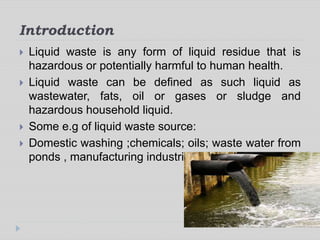Reclaim Waste - An Overview
Table of ContentsThe Best Guide To Reclaim Waste3 Simple Techniques For Reclaim WasteExamine This Report about Reclaim WasteOur Reclaim Waste Diaries5 Easy Facts About Reclaim Waste Described
Discover the types, incidents, and kinds of liquid waste. Domestic sewage waste refers to the waste and items from a domestic sewage-disposal tank. This type of waste is developed by human beings in houses, schools, and various other structures. This only includes sewage-disposal tanks that have a drainpipe field. The correct administration and disposal of residential sewage waste need fluid waste to be moved to a sewage therapy plant where the appropriate methods and tools are related to cleanse and deal with waste.
Business waste often includes potential dangers, such as combustible materials or a mix of liquid and strong waste products, and requires an advanced and comprehensive disposal procedure. The disposal of business waste typically includes the filtration of waste before transport to guarantee safe and correct disposal. Industrial waste is created from results and drainage of commercial procedures and manufacturing.
This kind of waste can not use the very same sewer management transportation or procedures as septic or commercial liquids. The hazardous waste administration procedure requires the assessment and testing of fluid waste prior to it undertakes the disposal procedure (liquid waste disposal). Overflow waste is the liquid waste that comes from overflow and excess stormwater in highly booming areas or cities
Overflow waste can trigger contamination and flooding if not managed correctly. Making certain correct waste monitoring can stop calamities and decrease ecological damage.
Some Known Details About Reclaim Waste
Get in touch with PROS Services today to find out about our waste administration and disposal solutions and the appropriate means to take care of the fluid waste you generate.
(https://pubhtml5.com/homepage/kwjac/)Do you know what happens to your water when you disengage, purge the toilet or drain pipes the cleaning device? No? Well, it deserves understanding. This supposed 'wastewater' is not only a crucial resource however, after therapy, will be released to our land, rivers or the ocean. Utilized water from bathrooms, showers, baths, kitchen sinks, laundries and commercial processes is referred to as wastewater.

water utilized to cool down machinery or tidy plant and devices). Stormwater, a kind of wastewater, is drainage that flows from farming and metropolitan locations such as roofing systems, parks, gardens, roads, paths and rain gutters into stormwater drains, after rain. Stormwater flows unattended straight to regional creeks or rivers, at some point getting to the ocean.
Some Of Reclaim Waste
In Queensland, many wastewater is treated at sewer treatment plants. Wastewater is transferred from domestic or industrial websites with a system of sewers and pump terminals, referred to as sewage reticulation, to a sewer therapy plant. Local federal governments construct, preserve and run most sewer therapy plants. Operators are accredited under the Environmental Management Act 1994 to discharge cured wastewater at an appropriate ecological criterion right into waterways.
The Division of Natural Resources encourages city governments concerning managing, operating and maintaining sewerage systems and treatment plants. In unsewered locations, regional federal governments may require homeowners to install specific or family sewage therapy systems to treat residential wastewater from bathrooms, kitchens, bathrooms and washings. The Department of Natural Resources authorizes using house systems when they are shown to be effective.
Most stormwater gets no therapy. In some new class, treatment of some stormwater to eliminate trash, sand and crushed rock has started making use of gross toxin catches. Wastewater treatment occurs in 4 phases: Gets rid of solid issue. Larger solids, such you can try this out as plastics and various other things incorrectly discharged to drains, are removed when wastewater is passed with displays.
Wastewater after that moves right into big tanks where solids settle and are gotten rid of as sludge. Oil and residue are skimmed from the surface. Uses small living microorganisms called micro-organisms to damage down and remove remaining liquified wastes and fine particles. Micro-organisms and wastes are included in the sludge. Eliminates nitrogen and phosphorus nutrients that could create algal blooms in our rivers and threaten aquatic life.
Getting My Reclaim Waste To Work
Nutrient elimination is not readily available at all sewer treatment plants since it requires pricey specialist devices. Clear liquid effluent produced after treatment might still consist of disease-causing micro-organisms - liquid waste removal melbourne.

The majority of wastewater moves into the sewerage system. Under the Act, regional federal governments carry out authorizations and permits for ecologically pertinent tasks (ERAs) including wastewater releases that may have a regional impact.
The Of Reclaim Waste
Monitoring provides accurate information about water quality and can confirm that licence conditions are being met. The details obtained through monitoring offers the basis for making water high quality decisions.